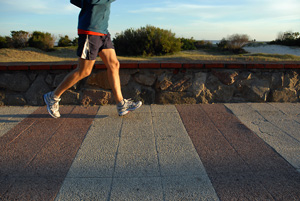 When deciding where to workout, dedicated runners have a plethora of options. Between barefoot running, trailblazing, asphalt, concrete and the local track, it can be difficult to decide what choice is right for you.
When deciding where to workout, dedicated runners have a plethora of options. Between barefoot running, trailblazing, asphalt, concrete and the local track, it can be difficult to decide what choice is right for you.
Dr. Charles A. Mutschler, DPM is a medical director and podiatrist at Advanced Footcare of Miami. As an expert in the field, he acknowledges the fact that all types of running surfaces can provide both risks and benefits to the runner.
Running on sand, grass and dirt trails are all very common practices. Although running on these surfaces provides incredible shock absorption and muscle development, the uneven ground can contribute to slips, trips and falls. Runners who are not accustomed to the irregular terrain may find themselves straining and spraining the muscles in their feet and ankles.
Running on asphalt and concrete provides a more constant mode of travel with less chance of stressing the muscles in your feet and ankles. However, the general school of thought is that running on such hard surfaces provides greater impact on the joints, thus creating more risk of injury. A story in the New York Times challenges that common thought and questions its scientific validity.
The article questions Dr. Hirofumi Tanaka, an exercise physiologist. Dr. Tanaka turned a wary eye towards the topic of running terrain after he sustained a knee injury. An orthopedist recommended that Dr. Tanaka run on soft surfaces, in order to facilitate successful healing of the injury.
Unfortunately, the advice didn’t bode well for him. Dr. Tanaka twisted his ankle while running on a dirt path and aggravated his existing knee injury. After the incident, he dedicated his time and resources to seeking out professionals that may shed some light on the subject. What he found was a bit inconclusive.
 According to the article, the problem is that “there are no rigorous gold-standard studies in which large numbers of people were assigned to run on soft or hard surfaces, then followed to compare injury rates.” There have been many studies that address the question of hard versus soft running surfaces indirectly but in those cases, there really isn’t enough information to solely advocate one over the other. In fact, they seem to suggest that the body will adapt (over time) to any surface.
According to the article, the problem is that “there are no rigorous gold-standard studies in which large numbers of people were assigned to run on soft or hard surfaces, then followed to compare injury rates.” There have been many studies that address the question of hard versus soft running surfaces indirectly but in those cases, there really isn’t enough information to solely advocate one over the other. In fact, they seem to suggest that the body will adapt (over time) to any surface.
Lacy Hansen, resident running expert here at DietsInReview, reiterates that running on soft ground doesn’t always provide the benefits we assume it will. “I’ve always been told that softer surfaces create a lighter impact on the body and of course less impact lowers the risk of injury… However, softer surfaces typically come in the form of off road terrain which presents different risks, despite [the] possible benefits,” says Hansen.
So what’s a runner to do? Dr. Mutschler offers his advice: “All weather tracks are probably one of the best surfaces. They give the stability of the concrete or asphalt with the cushioning comparable to natural grass.” Though Dr. Mutschler’s advice makes sense and provides a sensible medium for recreational runners, there’s little scientific evidence to clearly point in one direction or the other. The studies just aren’t there to back up any of the most common theories.
The truest answer may vary based on what your ultimate goals (and personal preferences) are. For example, if you are training for a marathon that will be run on asphalt, then it would probably be best to train on asphalt. Regardless of which modality you go with, choose the right running shoes for the job! Wearing the wrong running shoes could make all the difference. Also, if you plan on switching things up and changing which type of surface you run on, take the time to do it slowly. It may take a bit of effort for your body to adapt to the new terrain.
Also Read:
